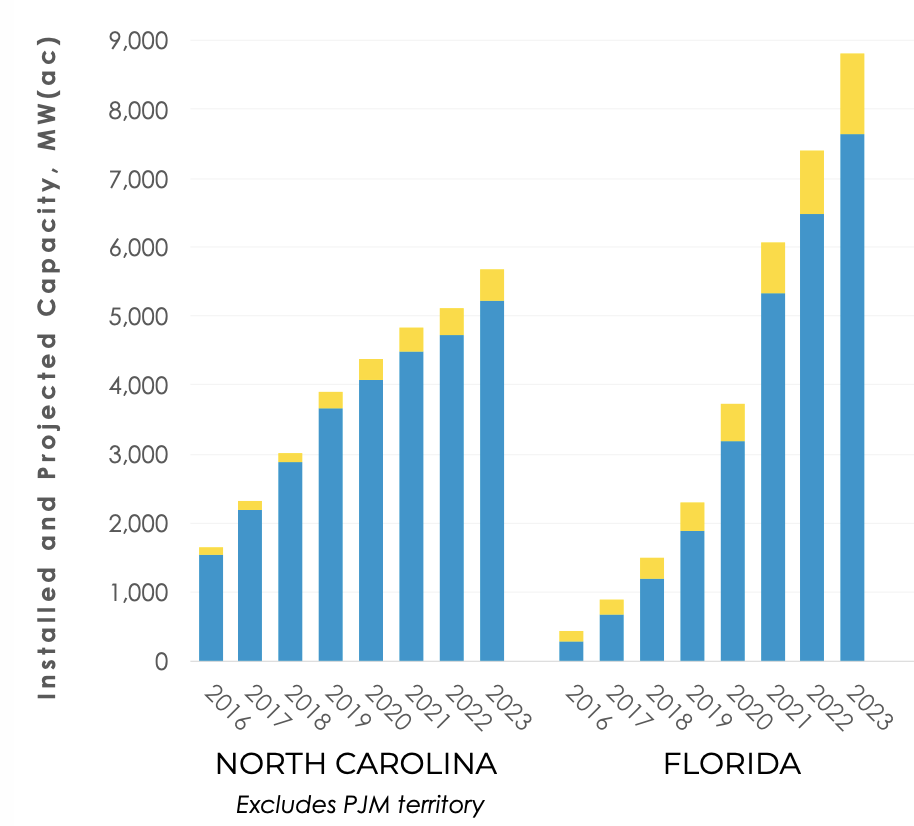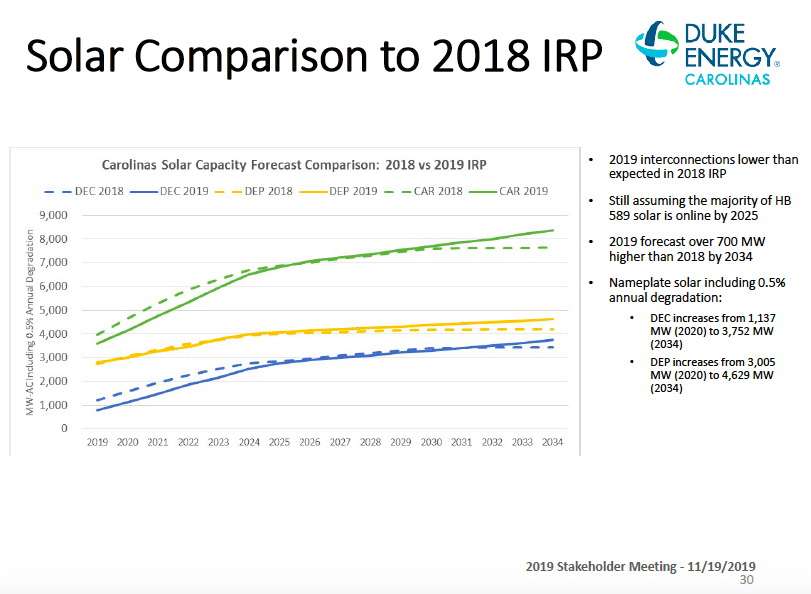Florida will surpass North Carolina on total installed solar capacity even sooner than expected. This third blog about our recent 'Solar in the Southeast' annual report shines some light on the updated forecast for those two states.
Bryan Jacob | July 9, 2020 | Florida, North Carolina, Solar, UtilitiesIn both the first blog and the second about this year’s annual Solar in the Southeast report, I emphasized that Florida will surpass North Carolina on total installed solar capacity even sooner than expected. SACE is now projecting the Sunshine State to overtake the Tarheel State in 2021. That phenomenon deserves a little more attention, so I offer additional detail today.

Interconnection delays are constraining the near-term North Carolina forecast (reduced from prior years) while projects like Florida Power & Light’s (FPL) SolarTogether have accelerated the Florida forecast.
Let’s look at North Carolina first:
The main change is that the two Duke utilities in the state, Duke Energy Progress (DEP) and Duke Energy Carolinas (DEC), filed interim updates to their Integrated Resource Plans (IRPs) in 2019. These updates actually increased the plans for solar over the full 15-year time horizon but reduced the near-term plan. Below is a comparison Duke presented at a stakeholder forum to compare the 2019 update with the 2018 IRP.

SACE incorporated the 2019 IRP update and that resulted in a lower forecast for North Carolina over the rolling four-year time horizon for Solar in the Southeast. SACE had been anticipating 6,000 megawatts (MW) of solar in North Carolina for 2022. That forecast is now tempered to 5,100 MW (and still less than 6,000 MW for 2023) with a portion of that capacity serving customers in South Carolina.
As indicated on the above slide, 2019 interconnections were lower than anticipated in the 2018 IRP. The North Carolina Utilities Commission (NCUC) has been trying to resolve this issue for quite some time and a suitable queue reform seems imminent. Will Driscoll explored this regulatory reform with an article in pv magazine on July 6.
Duke is presently preparing new IRPs for their North Carolina and South Carolina utilities. These will be filed later this year and represent an opportunity to resume the pace of solar development. SACE is involved in stakeholder dialogues to inform these planning processes.
Now for Florida:
In last year’s report, SACE had already incorporated the 30-by-30 announcement from Florida Power & Light to install more than 30 million solar panels by 2030. Since then, however, FPL received approval for SolarTogether, the largest community/shared solar program in the country. This approval accelerated the schedule for FPL’s 30-by-30 and increased the near-term solar forecast for Florida.
As I’ve mentioned previously, FPL can’t solely claim credit for the increase in the Florida forecast. Several other utilities have announced expansions of their solar portfolios, as well.
- Tampa Electric (TECO) is currently fulfilling its prior pledge to build 600 MW of solar but has already announced an additional 600 MW by 2022.
- Florida Municipal Power Agency (FMPA) has just brought online 149 MW out of its initial 223.5 MW commitment – and has already awarded contracts for an additional 149 MW.
- Gainesville Regional Utilities announced a 50 MW project.
Each of these is already reflected in the Solar in the Southeast annual report forecast. And there are others presently pending. For example, SACE is party to a stipulation filed by Duke Energy Florida (DEF) just last week (a 750 MW shared-solar program called Clean Energy Connections). If approved by the Florida Public Service Commission, this will increase the four-year forecast for DEF and the state.
No doubt other solar plans will be expanded and the next annual report will reflect even more Solar in the Southeast.
Download the Report
Watch The Webinar
Read the Report Blog Series
#SSR2019